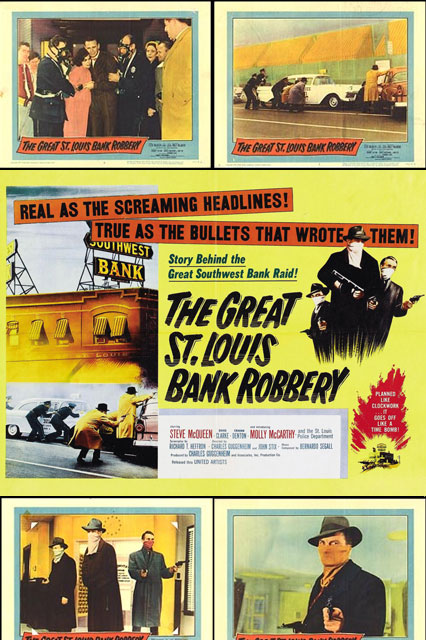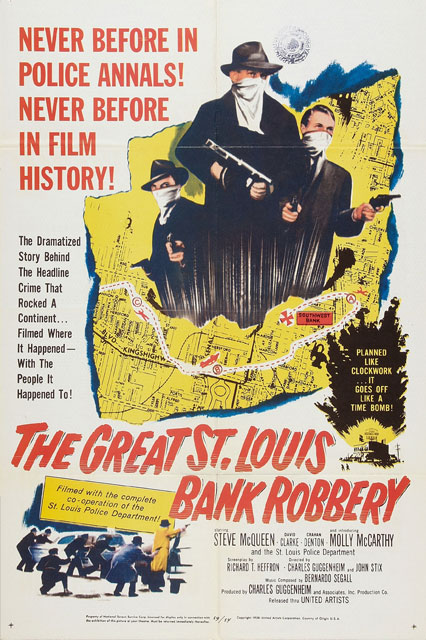A New Kind of Bandit:
The Great St. Louis Bank Robbery
1959
On the surface 1959’s The Great St. Louis Bank Robbery seems not unlike any of a hundred other low-budget heist pictures from the ‘50s. Some men get together, make elaborate plans, and then try to pull off a bank job. It has two things working to its advantage, however. It’s an early starring vehicle for a young Steve McQueen (playing George, the hesitant novice wheelman), and it’s based on a true story.
Director Charles Guggenheim uses the latter fact to his advantage. A documentarian by trade, Guggenheim makes his first (and one of his very few) narrative film in a documentary style, filming on the actual locations of the source events and using some of the real players as actors. Still, it could easily be taken as just another heist film, albeit a good one. What makes the film stand out today is the script, by first-time screenwriter and future television director Richard T. Heffron, which makes no bones about the homosexuality of the central characters (played by Crahan Denton and James Dukas). It’s not difficult to find gay characters in noir-era films if you’re looking for them. Consider Murder My Sweet, The Big Combo, or Don Siegel’s The Line-Up. But rarely are the characters more obvious or more disturbing than in The Great St. Louis Bank Robbery.
The first hint comes in the opening scene, in which Jon—a rugged, older ex-con (Denton in a remarkable and absolutely unique performance)—lays out the basic plan and divvies up the responsibilities and ground rules. “Stay away from women until the job’s done,” he warns. As the film progresses, we learn how serious he is about that warning, and why.
The most revealing scene, however, takes place in a hotel room in which Jon and his long-time partner Willie discuss the situation in private. Willie (Dukas) is a whiny, baby-faced, bespectacled younger ex-con. We learn in fairly obvious terms that in prison, Willie had been Jon’s punk. “I thought they were gonna kill you that first week,” Jon tells him. “Then I came along to protect you.”
Willie was a once-pretty boy who has since let himself go a little. Jon’s getting tired of Willie after all these years, and has set his sights on someone a little younger and more attractive—namely George (McQueen). After the job, we learn, Jon plans to take George to Mexico with him to be his new boy.
The brief exchange helps explain Willie’s clear jealousy of George through the rest of the film, even as George himself remains clueless as Jon leers at him in nearly every scene. When Willie takes to stalking George and spots him talking with a young woman (Molly McCarthy, who made a career of playing the long-suffering girlfriend of assorted criminals), well everything goes to hell.
Of course Jon is revealed to be insane and his misogyny takes a violent turn, and Willie is childish, sniveling, and effeminate, but apart from that what remains interesting about their presentation is that it’s done so naturally and straightforwardly. These men are not flouncing caricatures. It was a rare thing to see at the time—almost as rare as references to gay rape in prison. One also has to wonder if all this is part of the reason why the film is not terribly popular among typical Steve McQueen fans—or why at the end of the film, when a hostage says that George is “an animal” like the rest of the bank robbers, he begins to whimper “I’m not like them!”
-Jim Knipfel
Copyright 2015

